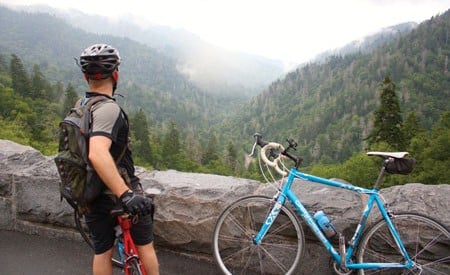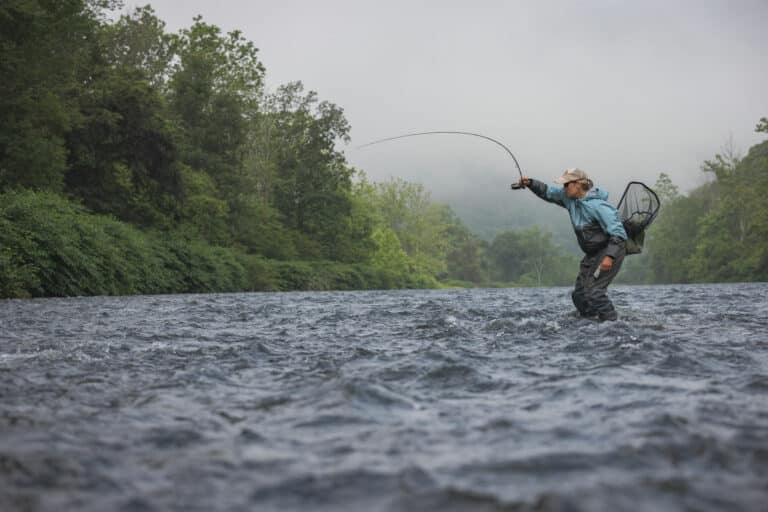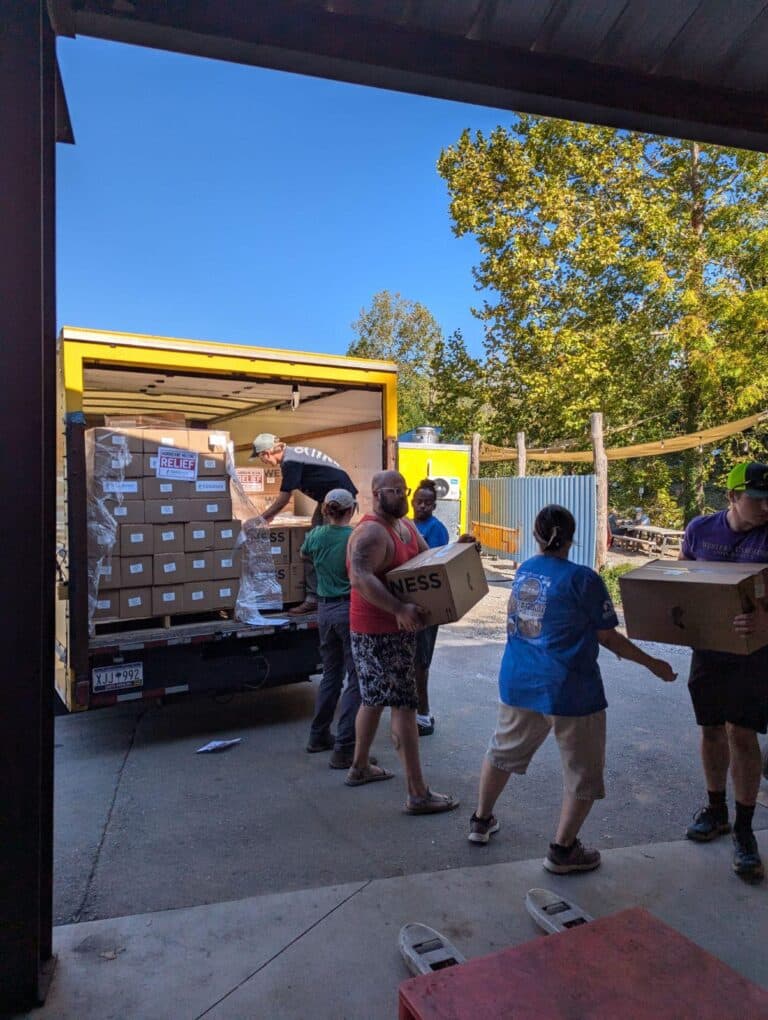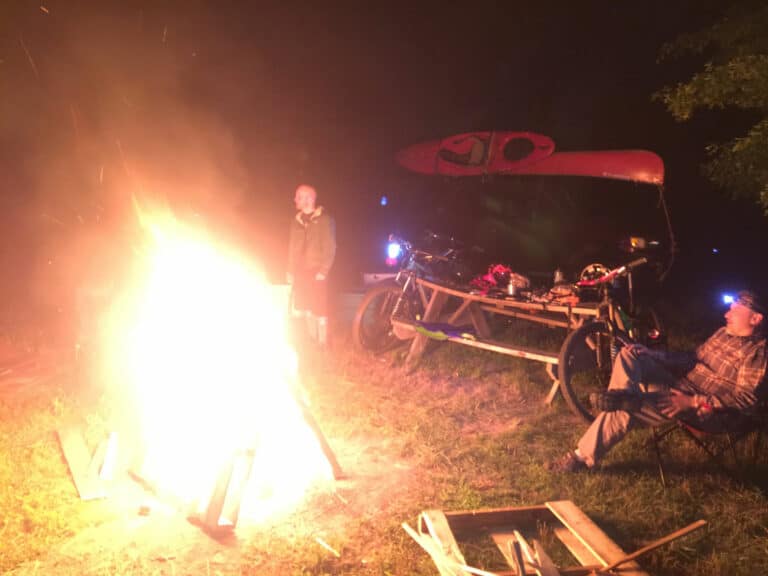“This isn’t a race,” I say as we pedal slowly out of the Oconaluftee Visitor’s Center, swerving onto the blacktop of Newfound Gap Road. Then I pedal a little faster, pulling ahead of the group. “I mean I’m winning, but it’s not a race.”
Newfound Gap Road (aka US 441) runs for 33 miles across Great Smoky Mountains National Park. Cherokee, N.C., and Gatlinburg, Tenn., bookend the road. In between, the road climbs steadily to Newfound Gap, forming a beautiful crossroads with the Appalachian Trail, roughly a mile above sea level. It’s one of the most scenic stretches of asphalt in the South, the only paved route through the middle of the park’s 500,000-acre wilderness. Drive it, and you’ll cruise by elk herds in the Oconaluftee Valley, old growth forests near the Sugarlands Valley, and remote peaks and dramatic overlooks in between. It’s one of those roads everyone with a driver’s license feels obligated to cruise, which is exactly why you don’t hear much chatter about bicyclists bothering with it. Newfound Gap Road is crazy busy with traffic.
“It’s a phenomenal ride,” says David Worth, a road cyclist at the NOC’s Gatlinburg store. “Newfound Gap offers the longest uphill you’ll find around here, and a downhill that’s an absolute blast. But the road is full of drivers with divided attention. We’re talking about a high volume of cars.”
Worth says most local riders eschew cycling Newfound Gap road for lower-traffic options outside of the park. It’s a safe, responsible choice. But if Newfound Gap Road is such a phenomenal ride, why should motorists have all the fun? I convinced two roadie friends, Jeremiah LeRoy and Tim Grotenhaus, to put their lives on the line with me on an exploratory journey to see if riding Newfound Gap Road is worth fighting throngs of minivans and RVs.
We get a late morning start, so the elk, which have been known to gather in the meadow next to the Oconaluftee Visitor’s Center in the early morning, are long gone as we pedal west. The road cruises gently along the Oconaluftee River for the first few miles, rising only slightly as we move deeper into the park. It gives us a chance to loosen up and discuss the plan. We’re going to ride the entire Newfound Gap Road to Gatlinburg and back. Sixty five miles, a minimum of 6,000 feet of climbing. It’ll probably rain, because the park is essentially a rain forest, and there’s a good chance we’ll get hit by a car.
It’s a relentless 10-mile climb to the gap. We settle into a manageable pace and each get sucked into the mental grind that takes over when you’re on a long climb. Tim sings Miley Cyrus songs to himself. Jeremiah thinks about what his spirit animal might be. The ferns and moss that line the forest floor around the road are slick from a recent rain, and small seasonal creeks crash through small gullies in the ridges that rise from the road.
We decide the safest approach is to ride as a single-file, close-knit unit. We’re like a snake moving slowly, carefully up the edge of the road. I think about the local cyclists wisely making the choice to eschew the traffic of Newfound Gap Road after a Lexus passes, giving me roughly four inches of space between my handlebars and his side mirror.
It takes two hours to pedal from the visitor’s center to the crest. We top out at lunch time and Newfound Gap is a zoo. Throngs of Japanese tourists and families from Georgia in overstuffed minivans jockey for the best spaces in the oversized parking lot—the spots closest to the Appalachian Trail trailhead. We pedal our bikes to the farthest end of the parking lot and eat energy bars and psych ourselves up for the next stretch, a bomber descent from the gap to Sugarlands Valley. It’s a 13-mile downhill that I figure will take us 20 minutes. And it doesn’t disappoint. The word epic is thrown around a lot in the biking world, but this descent honestly deserves the title. The road curves constantly, passes through a few short tunnels, and even forms a full 360-degree corkscrew at one point on its drop from the gap. We hit 40 miles per hour, only occasionally tapping the brakes, easily keeping up with traffic. The reprieve from getting passed by cars is a relief, and somehow, the balls-to-the-wall descent feels safer than the climb.
Soon we’re pedaling into downtown Gatlinburg, which feels like a cartoon compared to the forest we just rode through. The town is full of Dippin’ Dots and video game parlors. Super Fun Zone! Ripleys! Moonshine! Everything in town has an exclamation point beside it. I’m not ashamed to say I love it.
We drink ice-cold Pacificos on the porch of a Mexican restaurant that overlooks the river, and discuss how incredible a legitimate race up and down Newfound Gap Road would be. The sun is shining, we’re fresh off two beers, and feeling good as we pedal back out of town and into the park. Then the climbing starts again, steeper on this side of the mountain, or maybe we’re just fatigued from already having ridden 30 miles.
My legs feel heavy as we begin the 13-mile slog back up to Newfound Gap, but my main concern is the traffic. It’s a non-stop litany of jeeps and RV’s from Florida, all playing a game to see how close they can get to us without knocking us over.
The good news about the climb from Gatlinburg to the state line is that you have the time to enjoy the scenery. In the Sugarlands Valley, you ride between towering, massive old-growth trees that line the sides of the road. Rain starts and stops and we spend most of our time riding through a thick fog. Occasionally, the fog thins, giving us big views from roadside overlooks, revealing dank, dark green peaks, practically shining from the constant precipitation.
We speed through Newfound Gap as we top out for the second time, in a hurry for the next downhill through the park’s thick forest that leads back to our car. I dream about warm, dry clothes as we drop fast off the mountain. Mostly, though, I dream about a car-free day inside the park. One day out of the year when Newfound Gap Road becomes a haven for cyclists to enjoy, an opportunity to enjoy the fruits of the park on two wheels without fighting the barrage of cars.
IF YOU GO
Traffic on Newfound Gap Road is no joke. It’s a beautiful ride, but you’re definitely subject to the whims of passing cars on a massive scale. Like everything in life, this ride is about timing.
“If you hit it at the right time, it can be a lot of fun,” says David Worth. “Early morning or in the evening are lower traffic. And weekdays after school starts are good.”
Your best bet for a low-traffic Newfound Gap Road experience is to aim for a brief window in November. Show up to ride after the leaf peepers are gone but before the snow falls lead to road closures in the dead of winter, and you’ll find the road is more biker friendly.
Logistics: You can park a car at either Sugarlands Valley Visitor’s Center or Oconoluftee Visitor’s Center. Expect 60+ miles (depending on how much you cruise around Gatlinburg) and 7,100 feet of elevation gain with gradients that hit 12 percent.
Plan B
Other bike options in Great Smoky Mountains National Park include:
Cades Cove Loop: This 11-mile paved road through popular Cades Cove on the Tennessee side of the park is closed to cars on Wednesday and Saturday mornings (from May through September). But you’ve got to get there early. Cars are allowed back on the road at 10am.
Foothills Parkway West: The Foothills Parkway climbs and traverses the ridge of Chilhowee Mountain for 18 miles, offering decent climbs and more than decent views (and far less traffic than Newfound Gap).
Balsam Mountain Road: If you have a mountain bike or cross bike, Balsam Mountain Road is your best bet. The gravel road starts where the Blue Ridge Parkway ends, then travels one way through a quiet corner of the park for 28 miles.







